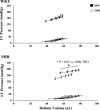Exercise training improves systolic function in hypertensive myocardium
- PMID: 21921241
- PMCID: PMC3233879
- DOI: 10.1152/japplphysiol.00292.2011
Exercise training improves systolic function in hypertensive myocardium
Abstract
The general purpose of this study was to test the effect of exercise training on the left ventricular (LV) pressure-volume relationship (LV/PV) and apoptotic signaling markers in normotensive and hypertensive hearts. Four-month-old female normotensive Wistar-Kyoto rats (WKY; n = 37) and spontaneously hypertensive rats (SHR; n = 38) were assigned to a sedentary (WKY-SED, n = 21; SHR-SED, n = 19) or treadmill-trained (WKY-TRD, n = 16; SHR-TRD, n = 19) group (∼60% Vo(2 peak), 60 min/day, 5 days/wk, 12 wk). Ex vivo LV/PV were established in isovolumic Langendorff-perfused hearts, and LV levels of Akt, phosphorylated Akt (Akt(Pi)), Bad, phosphorylated Bad (Bad(Pi)) c-IAP, x-IAP, calcineurin, and caspases 3, 8, and 9 were measured. Heart-to-body weight ratio was increased in SHR vs. WKY (P < 0.05), concomitant with increased calcineurin mRNA (P < 0.05). There was a rightward shift in the LV/PV (P < 0.05) and a reduction in systolic elastance (E(s)) in SHR vs. WKY. Exercise training corrected E(s) in SHR (P < 0.05) but had no effect on the LV/PV in WKY. Caspase 3 was increased in SHR-SED relative to WKY-SED, while Bad(Pi,) c-IAP, and x-IAP were significantly lower in SHR relative to WKY (P < 0.05). Exercise training increased Bad(Pi) in both WKY and SHR but did not alter caspase 9 activity in either group. While caspase 3 activity was increased with training in WKY (P < 0.05), it was unchanged with training in SHR. We conclude that moderate levels of regular aerobic exercise attenuate systolic dysfunction early in the compensatory phase of hypertrophy, and that a differential phenotypical response to moderate-intensity exercise exists between WKY and SHR.
Figures




References
-
- Bing OH, Ngo HQ, Humphries DE, Robinson KG, Lucey EC, Carver W, Brooks WW, Conrad CH, Hayes JA, Goldstein RH. Localization of alpha1(I) collagen mRNA in myocardium from the spontaneously hypertensive rat during the transition from compensated hypertrophy to failure. J Mol Cell Cardiol 29: 2335–2344, 1997 - PubMed
-
- Bratton SB, Cohen GM. Apoptotic death sensor: an organelle's alter ego? Trends Pharmacol Sci 22: 306–315, 2001 - PubMed
-
- Cardone MH, Roy N, Stennicke HR, Salvesen GS, Franke TF, Stanbridge E, Frisch S, Reed JC. Regulation of cell death protease caspase-9 by phosphorylation. Science 282: 1318–1321, 1998 - PubMed
-
- Chicco AJ, McCune SA, Emter CA, Sparagna GC, Rees ML, Bolden DA, Marshall KD, Murphy RC, Moore RL. Low-intensity exercise training delays heart failure and improves survival in female hypertensive heart failure rats. Hypertension 51: 1096–1102, 2008 - PubMed
-
- Chobanian AV, Bakris GL, Black HR, Cushman WC, Green LA, Izzo JL, Jr, Jones DW, Materson BJ, Oparil S, Wright JT, Jr, Roccella EJ, National Heart L, Blood Institute Joint National Committee on Prevention, Detection, and Evaluation, and Treatment of High Blood Pressure, and National High Blood Pressure Education Program Coordinating Committee The Seventh Report of the Joint National Committee on Prevention, Detection, Evaluation, and Treatment of High Blood Pressure: the JNC 7 report. JAMA 289: 2560–2572, 2003 - PubMed
Publication types
MeSH terms
Substances
Grants and funding
LinkOut - more resources
Full Text Sources
Medical
Research Materials
Miscellaneous

